Let’s dive into the New Star Beginner Quilt Course Supplies and Tools to see what you will need to succeed on your quilting journey! You will find links to the two Youtube Videos below as well as further down in the post.
New Start Beginner Supplies and Tools YouTube Video
New Star Beginner Sewing Machine Janome Mod-30
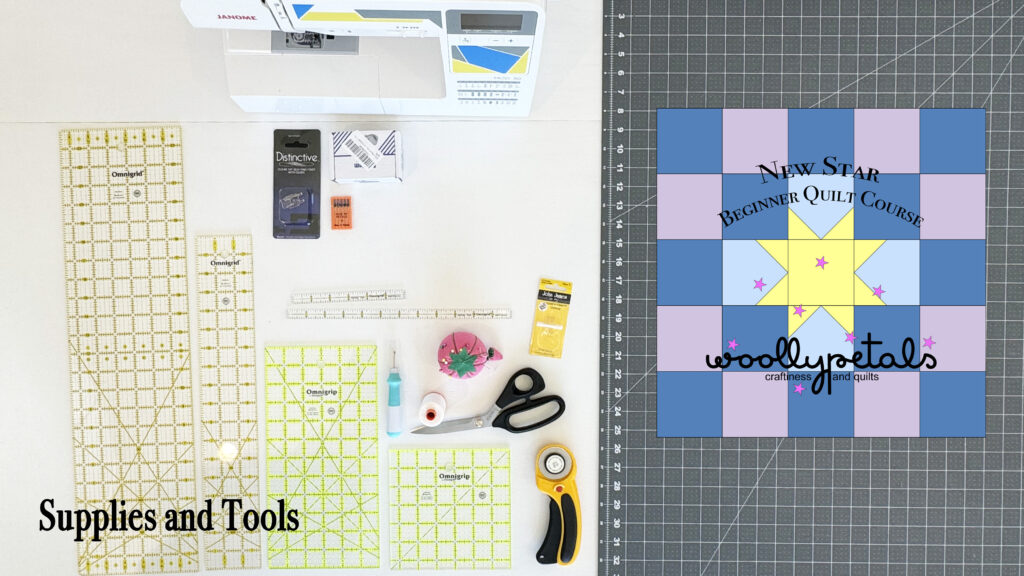
Tools
The tools I use on a regular bases while quilting are shared below. Some of the links are going to the manufacturers website so you can explore more options. But some are going directly to my friend Kristen’s Shop Kristens Craft Room. She has made bundles and listings for pre- order of most of the New Start Beginner Quilt Course Supplies and tools. I will talk more about that as you read on and get to the end of this post.
Cutting
- Cutting Mat – I love a good SELF HEALING cutting mat. I capitalized self healing because that’s important. In the past I have used a not self healing cutting mat and over time you get ridges and dips that disrupt the cutting. Not fun! This Fiskars 24″ x 36″ self healing cutting mat is great and bonus buy two and use them next to each other if you have the space. I have 2 of that exact mat and have used them for several years now. Always shop around for the best price.
- Rotary Cutter – Did you know that you cut most quilts out with a rotary cutter and ruler? When I started quilting it took a little bit of practice but make cutting out pieces quick and easy after you get used to it! I love the 45mm Olfa Ergonomic Rotary Cutter the best. I have used it for years and the ergonomic shape doesn’t bother my wrists. Luckily it has the feature of locking the blade out or in for safety. 45mm refers to the size of the blade. Which is important when buying new blades. Also check out the 60mm and 28mm. They are both great sizes for different types of projects.
- Scissors – I really love KAI brand scissors. I have several pair and have not had them dull with years of use.
- These KAI N5210 8″ fabric shears are a great pair to start your quilting with. However Kristens Craft Room has a great economy pair of Singer Scissors as well as the KAI scissors.
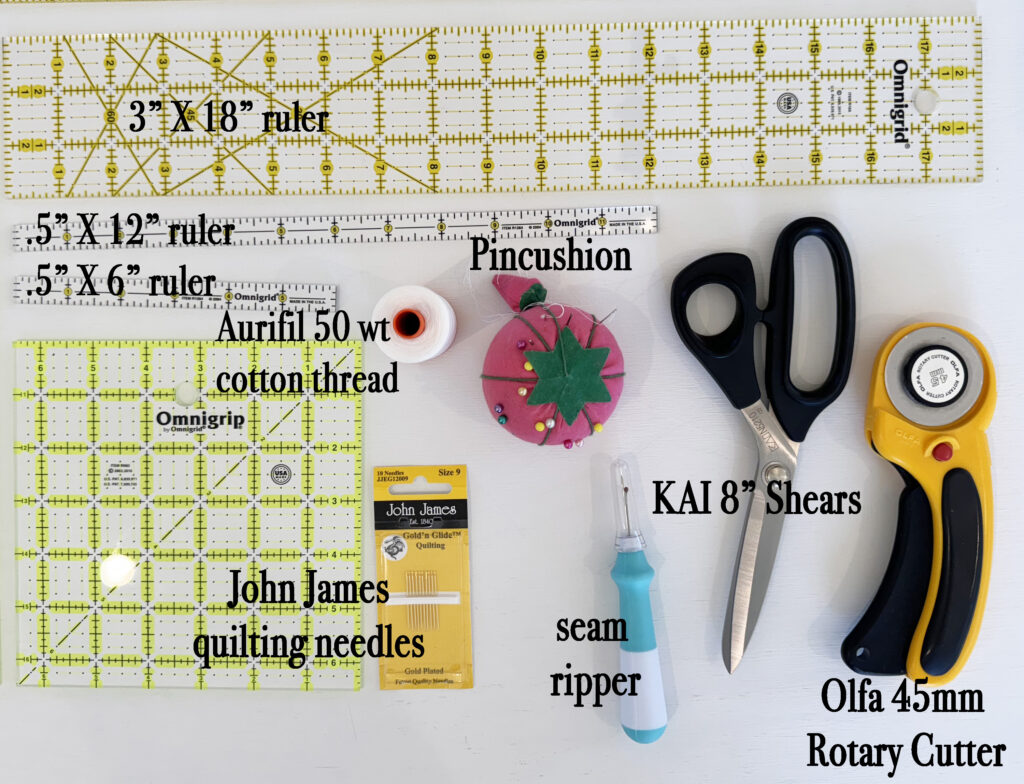
Rulers:
- Now this is a big section! I have a lot of quilting rulers but I am going to share the ones I recommend you start with. Then I will share some bonus ones that you may want to check out as you quilt more and determine what you will need. I like the brand Omnigrid. I would recommend sticking with one brand of rulers as much as possible as there can be the tiniest bit of discrepancy between brands. Definitely over time you will get multiple brands but try and start with one brand.
- 6.5″ X 24″ Omnigrid ruler is my go to big ruler. You will often need one to span at least half a width of fabric and 24″ will do the trick. I also prefer rulers that end in .5″ rather than a full inch since we tend to cut a lot of pieces out in .5″ increments.
- 6″ x 12″ Omnigrid ruler is a great mid size ruler. Often I am cutting out smaller pieces after cutting a full width strip and a smaller ruler is more manageable.
- 3″ x 18″ Omnigrid Angles ruler is a great skinny mid size ruler as well. Kristens Craft Room has subbed in a similar size. Having a ruler that is longer and skinny gives more flexibility.
- Omnigrid Marking Trio Ruler set is something I use almost every time I sew. They are the perfect skinny rulers to mark lines for HST’s or note where you need to line up fabric. Mine stay by my machine and get used so much!

Bonus Rulers:
- Some rulers I love to have because I cut these sizes a lot of square rulers. I have mostly Omnigrid versions in 12.5″, 10.5″, 6.5″, 4.5″, 3.5″ and 2.5″ squares. They come in really handy when I am cutting out those specific sizes.
- I also love the Bloc Loc rulers. They are a specially designed ruler with a groove to bump up against the seam of an HST or Flying Geese block to make aligning the ruler and trimming the block quick and easy. I have couple square sizes and love them.
- My last ruler that I highly recommend is the Stripology Ruler. I have the XL size and while it is an investment. So much time has been saved using this ruler. Basically you can align a bunch of fabric, lay this one ruler on top and cut in multiple grooves to cut out a lot of squares, strips, or rectangles at once.
- All of the rulers in this section are less of a need in quilting. I would recommend you try a few techniques and patterns and see what you sew the most and would use the most from this list. The you can add them to your Wish Lists.
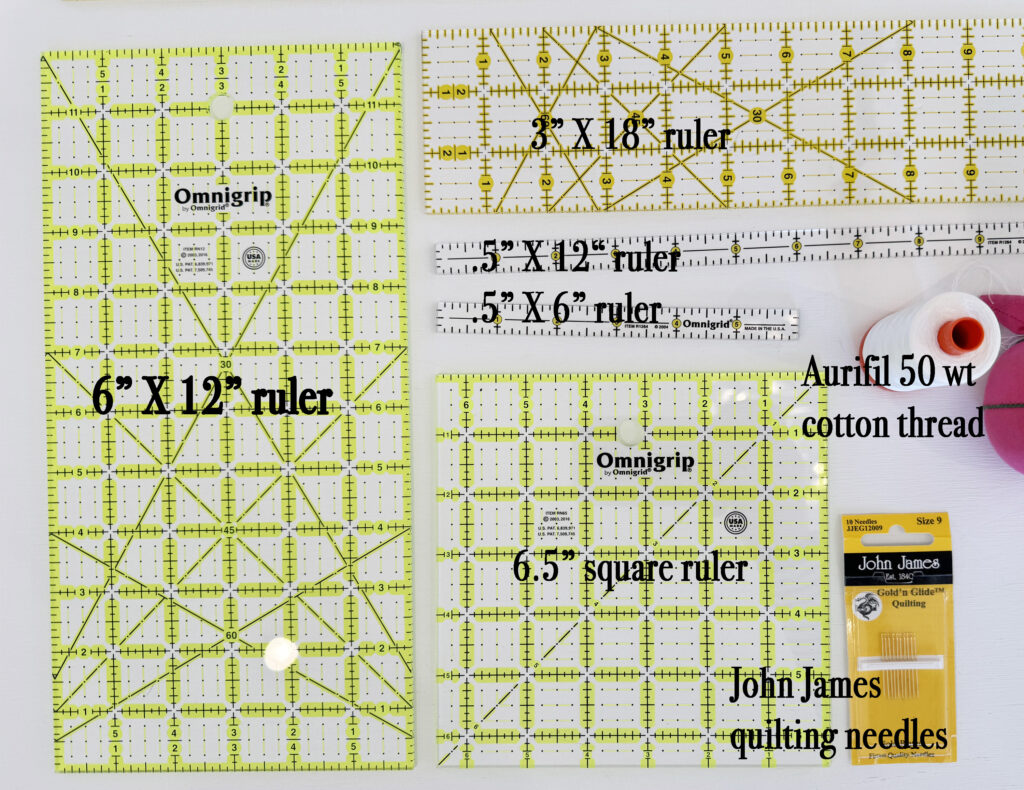
Sewing Notions:
Here are some essential you will need for sewing as well. This is a basic starting list.
- Seam Rippers – Yes you will need them and that’s okay. I would recommend having a few on hand because they will get lost or grow dull.
- Pins – These are essential as you are learning to quilt for accuracy. So don’t shy away from buying pins.
- Pincushion – A pincushion or a magnetic tray are perfect for storing all those pins for easy access. I use both pincushions and magnetic trays. Usually a magnetic try works best for me when pinning a large seam. Then catching those pins as I need to quickly remove and toss them aside will sewing. I more often us pincushions for hand stitching to hold needles and thread and a few pins I typically need for that.
- A pincushion is also a super fun project to make. My friend Mollie of Wild Olive as this adorable Pincushion tutorial on her site. Plus you can search Pinterest for lots of great pincushion tutorials.
- Needles – Sewing needles are a must. you will need them for little hand stitching things here and there. But hand sewing binding. For potentially burying threads while quilting. The John James needles I linked are my favorite for stitching with quilting thread. You will also need sewing machine needles but I’ll cover that with your sewing machine.
Thread:
Cotton quilting thread is a good place to start. I love the Aurifil Brand. It may seem a little pricier than your standard big box brand. But the spools hold more yards of thread and you can pick different weights of thread which is a great way to improve your piecing.
- Aurifil Thread 50 wt. is my go to choice for piecing. It’s thinner than your standard big box store thread and I find my machine do like it. But test out what works best for you and your machine. Some people have found it to linty, even using the same brand machines.
- Thread Weight – An interesting topic to learn about. But different weights of thread of good for different things. 50 wt is a nice piecing weight. 40 wt. is a nice quilting weight. 12 wt is a good hand stitching with big stitches weight. Basically remember the higher the number the thinner the thread and play around to find what works best for you. The average big box brand is 35 weight. The benefits of a lighter thread weight for piecing is it takes up less space in the seam. You will find sometimes that matters when you are piecing a complicated block with lots of pieces you need to be very accurate with that seam allowance and thinner thread can make a difference.
Sewing Machine:
Your sewing machine and accessories are really what can make or break your quilting experience. I have a whole blog post with a basic overview of a machine and its parts. All my machines, why I purchased them, and what I like or don’t like about them. As well as some recommendations from a handful of sewing friends on their machines.
But here I am going to share a Beginner Level Machine that I purchase to try out and recommend to you all looking to buy a machine. When purchasing wether you buy this one or a different one always read as many reviews as you can. That says a lot about a sewing machine.
The Janome Mod – 30 is what I purchased. I in general have liked Janome the best across multiple machines and when buying a less expensive machine, the Janome name gave me comfort. That said I hear lots of solid experiences with Brothers and Singers that give some good entry level price points as well.
My Janome Mod-30 was purchased on Amazon for $240 including shipping. I liked that it has a lot of the capabilities of a few of my other Janomes that cost more than double. The biggest difference is it has less stitches. But with quilting, and in my whole life sewing, since I was 8-9 years old, I rarely use all the extra stitches on sewing machines. YouTube Video about the Janome Mod-30 Sewing Machine.
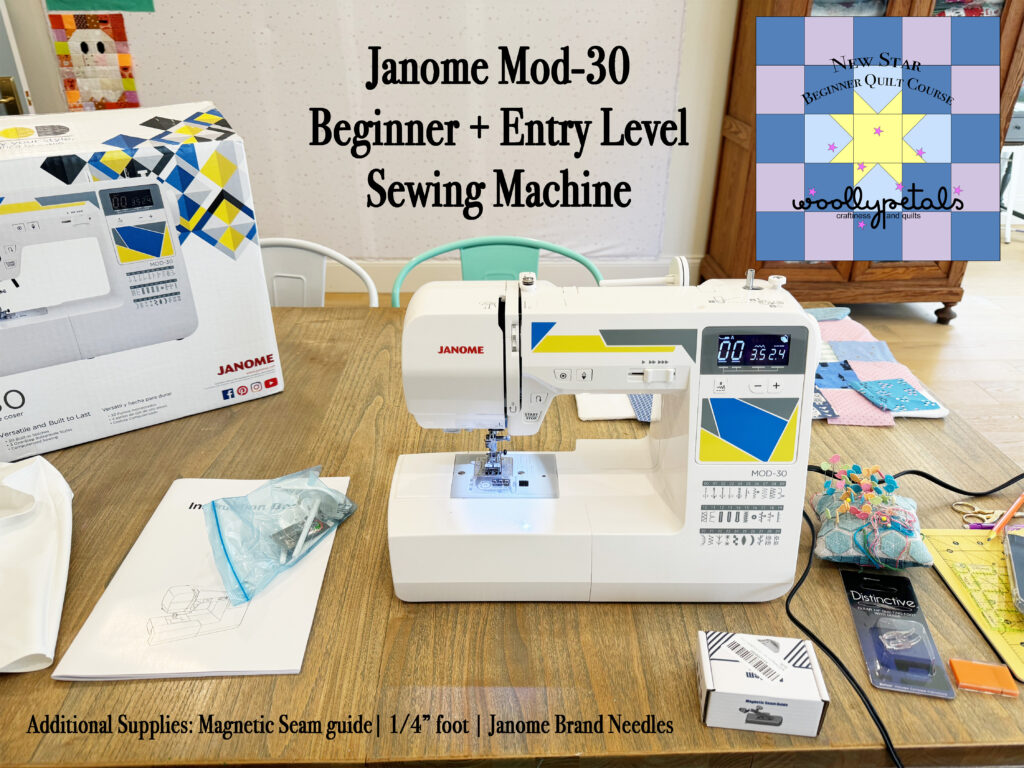
Sewing Machine Extras:
- Quarter Inch Foot – almost all quilting is pieced with a 1/4″ seam allowance. A 1/4″ foot means that it measures 1/4″ from the needle point to the outside edge of the foot. Sometimes that edge will have a guide that sticks out for the fabric to move against. The foot being a 1/4″ to the edge allows you to align the edge of the foot on the edge of the fabric and achieve an even 1/4″ seam allowance without to much effort. While I do love a 1/4″ foot with a guide, if you are changing between straight sewing and sewing HST’s or using the Stitch’n’Flip method you will have to swap feet as the guide gets in the way. Just something to think about. Find a quarter inch foot that works with your machine brand and model.
- Magnetic seam guide – This is a guide that attaches to your sewing machine surface. Magnetic is common, but I have seen ones that screw to a specific machine too. It gives the flexibility of using it for different width seam allowances which. As well as potentially saving time from swapping feet.
- Sewing Machine Needles – Janome has its own brand of needles that I do use in my janome machines for a little smoother sewing. Other sewing machine brands may have specific needles too. But I have used the Universal Brand Schmetz that a lot of shops sell. Quilting needles are ideal as they are more tapered and the taper helps them glide through more layers of fabric. The standard sizes are 75/11 and 90/14 the smaller number being the US size, as well as indicating a thinner needle. I typically use 75/11 for piecing and switch to the 90/14 for pouches or bags unless they require a heavy duty needle.
Supply Kits:
Like I mentioned above my friend Kristen, who owns Kristens Craft Room has put together some New Star Beginner Quilt Course Supple and Tool Kits for you to purchase. She has them grouped in Kits, and the items a la carte so you can purchase whichever combination you would like based on what you might have or want to try out. Click on the pictures below to go to her site.
Some of the things she does not have are the Cutting mats, Sewing Machines, the Bloc Loc and Stripology ruler, and well as some of the different squares sizes. I recommended my most used sizes to her. But let her know if your interested in her carrying other items. She may be able to get them for you.
For the Cutting Mat, since it’s large I highly recommend finding a store that will ship for free or even better a local shop.
When shopping for a sewing machine it is always best to check out a local sewing machine store if you have one to learn from the very knowledgeable people there. Even if you don’t purchase from them you will need a place to get your machine serviced so it’s good to start that relationship.
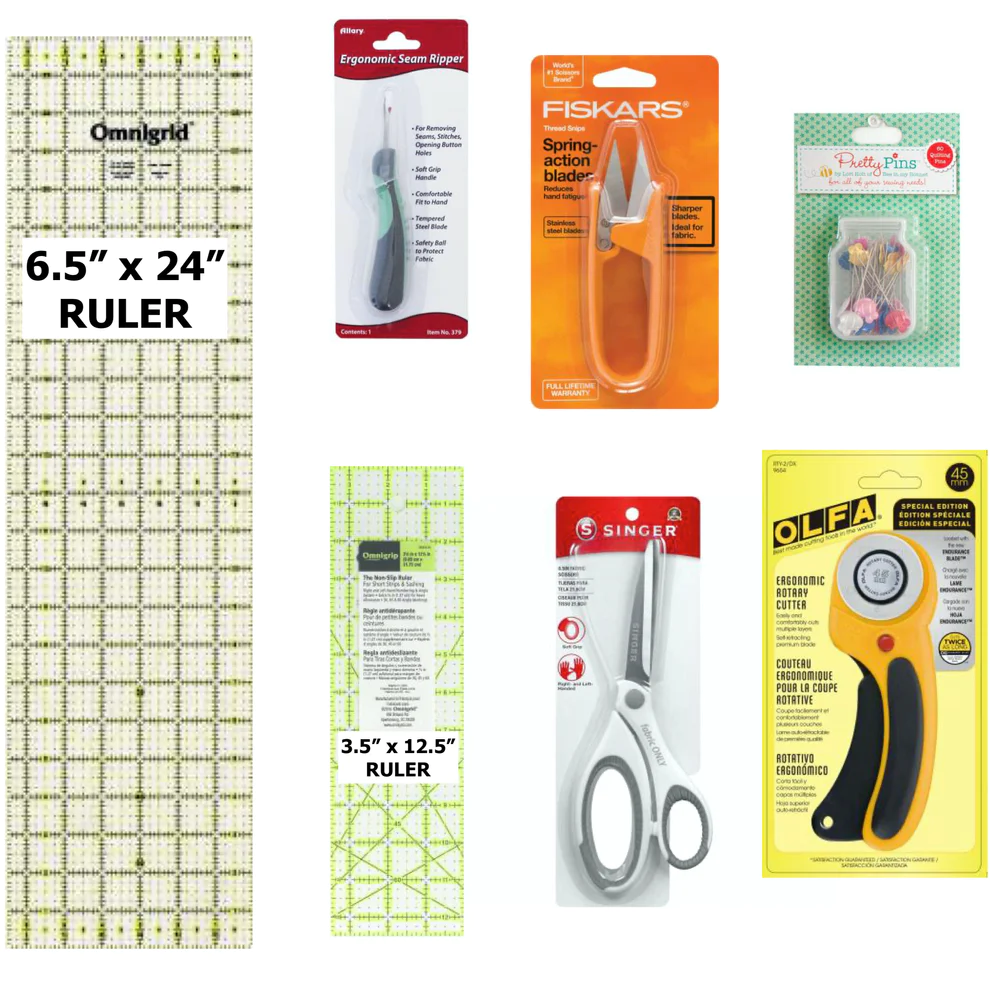
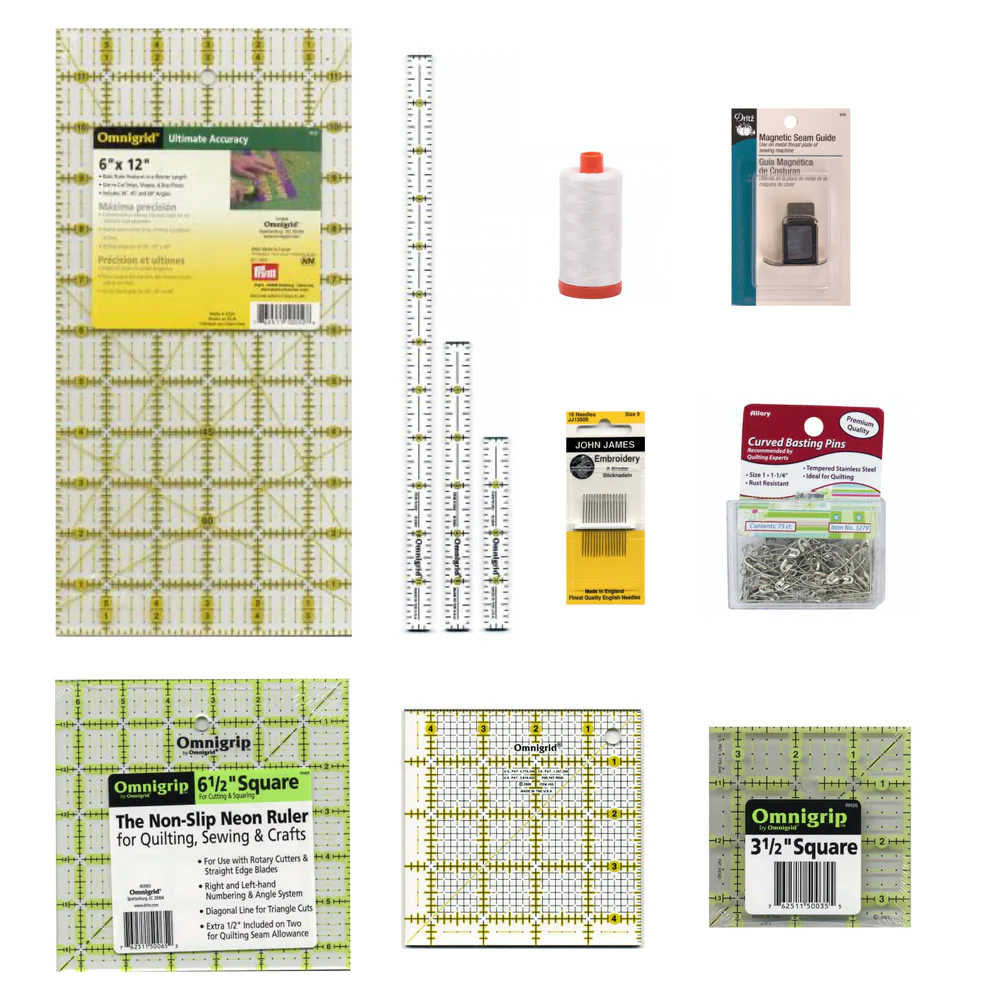
Fabric:
We’ll talk about fabric in another post since there is a lot of info about fabric and lots of places I want to recommend shopping for fabric. I know that’s a tease but I will be sharing soon!
Okay I think/hope you have a good handle on supplies to get you started in the quilting world. Here is the YouTube New Star Beginner Quilt Course Supplies and Tools video for all the supplies for the New Star Beginner Learn How to Quilt Course sharing a lot of these selections. If you aren’t here due to the Quilt Course go take a look at the info for that too! It’s Free and will be fully based here on my blog and YouTube.
Thanks for stopping by!

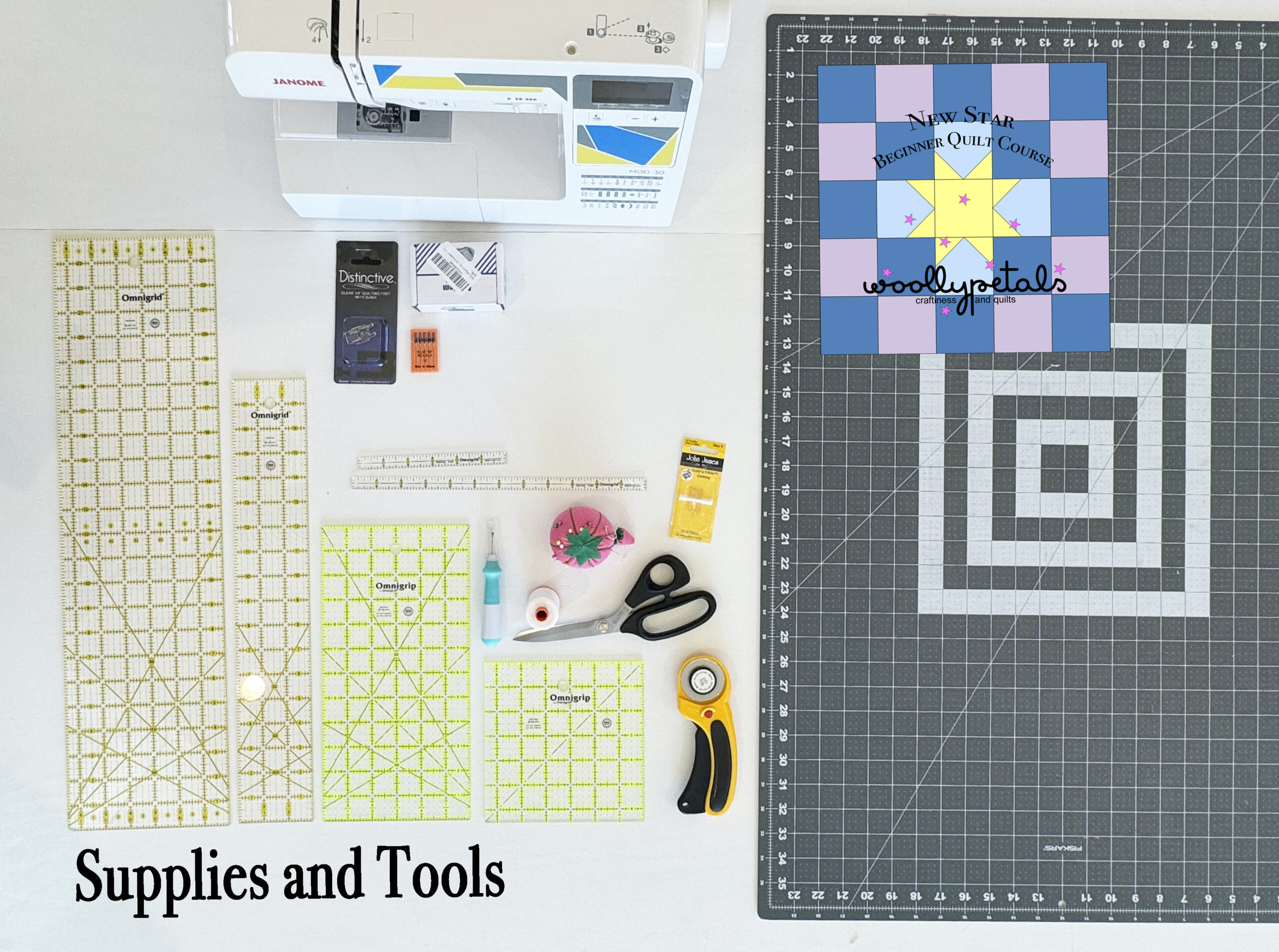
One thought on “New Star Beginner Quilt Course Supplies and Tools”